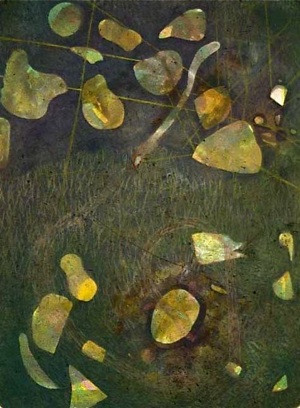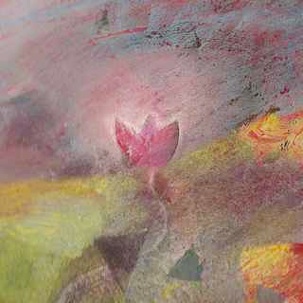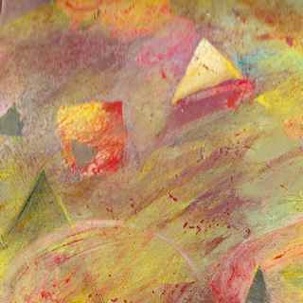Detail





The “triangle” is a beautiful shape in my minds eye. The triangle suggests to me a completeness. Within its structure is this, that and the other thing. The shape often surfaces by chance and gets emphasized during an organic approach to painting. The crisscrossing of brush strokes often develops a web of interlocking triangles which help to place other design elements within a painting. Looking closely into the painting I discover colors and forms that stand out amidst the rest. During the process it is tempting but useless to ask, “Why these shapes? Why these colors?” There is always a persistent “left-hemisphere” thinking pattern that wants to label a thought and get on with it. Part of the function of employing a non-premeditated approach to determining subject matter is that the vagueness can infuriate parts of our thinking processes which is just what we want. As Jung says,
“An habitual thought process will agitate the mind through the physical senses
and undergo transformation.”
Try saying that 72 times. The vagueness prepares a speechless state that is closer to actually saying something. Getting to that state is often half the struggle. Yet oncein the zone the painting paints itself.
The Art Crit #17
“Why did you put this line here and not there?”
?
“Did you intend for it to be orange?”
?
“Look up these artists in the library..........”
?
“They are putting their lines here and not there.”
!
“....and they are using red.”
- W. Zell
If this discipline is developed, a certain type of art is created, which speaks in ways one can not usually articulate yet resonates inside like a feeling of “confirmation”. This approach or Elemental Painting Process has also been described in a previous page.
The principles behind this painting technique is explored in Carl Jung’s writings. In his Foreward to Richard Wilhelms Translation of “The Book of Changes” he attempts to explore the effect chance and our state of mind (conscious or unconscious) has on the outcome of events in space and time.
“I have interested myself in this oracle technique, or method of exploring the unconscious, for it has seemed to me of uncommon significance.”
“If we leave things to nature, we see a very different picture: every process is partially or totally interfered with by chance, so much so that under natural circumstances a course of events absolutely conforming to specific laws is almost an exception.”
“The matter of interest seems to be the configuration formed by chance events in the moment of observation, and not at all the hypothetical reasons that seemingly account for the coincidence.”

“This assumption involves a certain curious principle that I have termed synchronicity, a concept that formulates a point of view diametrically opposed to that of causality. Since the latter is a merely statistical truth and not absolute, it is a sort of working hypothesis of how events evolve one out of another, whereas synchronicity takes the coincidence of events in space and time as meaning something more than mere chance, namely, a peculiar interdependence of objective events among themselves as well as with the subjective (psychic) states of the observer or observers.”
“If a handful of matches is thrown to the floor, they form the pattern characteristic of that moment. But such an obvious truth as this reveals its meaningful nature only if it is possible to read the pattern and to verify its interpretation, partly by the observer's knowledge of the subjective and objective situation, partly by the character of subsequent events. It is obviously not a procedure that appeals to a critical mind used to experimental verification of facts or to factual evidence.”
Above: “Laws of Attraction” , gouache, gold dust, watercolor by W.Zell

